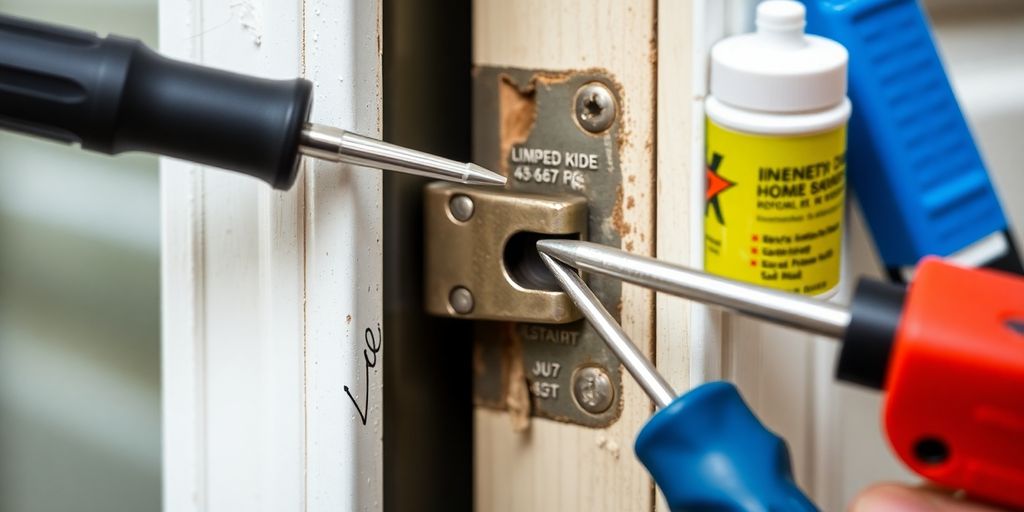
Ultimate Guide to Mobile Home Door Hinge Repair: Tips and Tricks for a Smooth Fix
Mobile homes are a great option for many people, but like any home, they come with their own set of challenges. One common issue is door hinges. If your mobile home door is sagging, squeaking, or not closing properly, it may be time for some hinge repairs. This guide will help you understand the basics of mobile home door hinge repair, from identifying problems to advanced fixing techniques.
Key Takeaways
- Identify the type of hinge your mobile home door uses to find the right repair methods.
- Regularly check and tighten screws to prevent hinges from becoming loose.
- Use wood filler or dowels for fixing stripped screw holes in hinges.
- Consider using hinge shims to adjust the alignment of your door if it’s not level.
- Don’t hesitate to call a professional if the damage is severe or if you feel unsure about the repairs.
Understanding the Basics of Mobile Home Door Hinge Repair

When it comes to mobile home door hinges, understanding the basics is essential for effective repairs. Hinges are crucial for the smooth operation of doors, and knowing how they work can save you time and effort.
Types of Hinges Used in Mobile Homes
Mobile homes typically use several types of hinges, including:
- Butt Hinges: Commonly used for standard doors.
- Continuous Hinges: Also known as piano hinges, they run the entire length of the door.
- Spring Hinges: These automatically close the door after opening.
Common Issues with Mobile Home Door Hinges
Some frequent problems include:
- Loose Hinges: Often caused by wear and tear.
- Squeaky Hinges: Resulting from lack of lubrication.
- Stripped Screw Holes: Occurs when screws become loose over time.
Tools Needed for Hinge Repair
To effectively repair hinges, you will need:
- Screwdriver: For tightening or removing screws.
- Drill: Useful for creating new holes if needed.
- Wood Filler: To fix stripped holes.
- Lubricant: To reduce squeaking and ensure smooth operation.
Regular maintenance can prevent many hinge issues. Keeping hinges lubricated and checking screws periodically can extend their lifespan.
For example, consider the wrs 3" standard garage door hinge with fasteners. This hinge is designed for durability and smooth operation, making it a great choice for mobile homes. It includes fasteners for easy installation, ensuring that your door functions properly for years to come.
Step-by-Step Guide to Fixing Loose Mobile Home Door Hinges
Identifying Loose Hinges
Loose hinges can cause doors to sag or not close properly. Identifying the problem is the first step. Check for:
- Screws that are visibly loose.
- Doors that don’t align with the frame.
- Gaps between the door and the frame.
Tightening Hinge Screws
Once you’ve identified the loose hinges, it’s time to tighten them. Here’s how:
- Gather your tools: a screwdriver and possibly a drill.
- Tighten each screw until it feels snug, but be careful not to strip the holes.
- Test the door to see if it swings smoothly.
Using Longer Screws for Better Support
If the screws are still loose after tightening, you may need to use longer screws. This can provide better support. Follow these steps:
- Remove the existing screws.
- Choose screws that are at least 1/4 inch longer than the original ones.
- Reinsert the new screws into the hinge, ensuring they grip the wood securely.
Using longer screws can help prevent future issues with loose hinges. This simple fix can save you from more extensive repairs later on.
By following these steps, you can effectively fix loose mobile home door hinges and ensure your doors function properly. Remember, regular maintenance is key to avoiding these issues in the future!
How to Repair Stripped Screw Holes in Mobile Home Door Hinges
Materials Needed for Repair
To effectively repair stripped screw holes in mobile home door hinges, gather the following materials:
- A drill
- Wooden dowels (3/8" diameter recommended)
- Wood glue
- A saw (if dowels need cutting)
- Sandpaper (for smoothing)
- Screwdriver
Drilling Out Old Holes
- Start by drilling out the existing holes using a 3/8" drill bit. This will create a clean space for the dowels to fit snugly.
- Ensure the depth of the hole matches the length of your dowels, allowing them to sit flush with the door frame.
- After drilling, check that the dowels fit properly before proceeding.
Inserting Wooden Dowels for a Secure Fix
- Apply wood glue to the dowels and insert them into the drilled holes.
- Allow the glue to dry completely, ensuring a strong bond.
- Once dry, use sandpaper to smooth any excess glue or rough edges.
- Finally, drill new pilot holes into the dowels and reinsert the screws.
Repairing stripped screw holes can be a straightforward task with the right tools and materials. Taking your time ensures a solid fix.
By following these steps, you can restore the functionality of your mobile home door hinges and prevent further issues. Remember, using quality materials like the wrs 3" black steel screen door hinge - 2 pack can enhance durability and performance.
Advanced Techniques for Severe Mobile Home Door Hinge Damage
When dealing with severe damage to mobile home door hinges, you may need to employ some advanced techniques to ensure a solid repair. These methods can restore functionality and extend the life of your door hinges.
Using Wood Filler for Large Holes
For hinge holes that are too large for simple fixes, wood filler can be a great solution. Here’s how to do it:
- Clean out any debris from the hole.
- Apply wood filler using a putty knife, slightly overfilling it.
- Allow the filler to dry completely.
- Sand the area smooth until it’s flush with the surrounding wood.
- Drill a pilot hole for the screw if needed.
- Reinsert the screw, being careful not to over-tighten.
This method creates a new, solid base for the screw to grip, effectively repairing even severely damaged holes.
Installing Hinge Shims for Better Alignment
Hinge shims can help adjust the position of a hinge or provide extra support when the wood around the hinge is damaged. Follow these steps:
- Remove the hinge from the door or frame.
- Place a hinge shim behind the hinge plate.
- Reattach the hinge, using longer screws if necessary.
- Adjust the shim as needed for proper door alignment.
Hinge shims help distribute the weight of the door evenly and provide a fresh surface for screws to grip.
When to Call a Professional
While many hinge issues can be fixed with DIY methods, some situations require professional help. Consider calling a pro if:
- The door frame is damaged or warped.
- Multiple repair attempts have failed.
- The door is an antique or made of valuable materials.
Remember, while DIY repairs can solve many issues, don’t hesitate to call a professional for complex problems or safety concerns.
In summary, using wood filler and hinge shims can effectively address severe hinge damage. If the problem persists, it’s wise to seek professional assistance to ensure safety and proper repair.
Preventative Maintenance Tips for Mobile Home Door Hinges
Regular Lubrication to Prevent Squeaks
Keeping your door hinges well-lubricated is essential. Regular lubrication can prevent squeaky noises that can be annoying. Use a suitable lubricant like WD-40 or a silicone spray. Apply it to the hinge pins and wipe off any excess. This will help keep the hinges moving smoothly.
Checking and Tightening Screws Periodically
Over time, screws can loosen due to regular use. Make it a habit to check the screws on your hinges every few months. If you notice any that are loose, simply tighten them with a screwdriver. This small step can prevent bigger issues down the line.
Replacing Worn-Out Hinges Promptly
If you notice that your hinges are rusted or damaged, it’s important to replace them right away. Ignoring worn-out hinges can lead to more serious problems. When replacing, ensure you choose the right type of hinge for your door.
| Maintenance Task | Frequency | Importance |
|---|---|---|
| Lubricate Hinges | Every 3-6 months | Prevents squeaks and rust |
| Check Screws | Every 3 months | Maintains door alignment |
| Replace Worn Hinges | As needed | Ensures door functionality |
Keeping up with these maintenance tips can save you time and money in the long run. Regular checks can help you catch issues before they become major problems.
By following these simple tips, you can ensure that your mobile home door hinges remain in good condition for years to come. Remember, a little maintenance goes a long way!
Troubleshooting Common Mobile Home Door Hinge Problems

Fixing Squeaky Hinges
If your door is making annoying squeaky sounds, it’s time to take action. Lubricating the hinges can often solve this problem. Here’s how:
- Use a lubricant like WD-40 or a specialized hinge oil.
- Apply the lubricant directly to the hinge pin.
- Open and close the door several times to work the lubricant in.
Addressing Unlevel Doors
An unlevel door can be frustrating. To fix this:
- Check if the door is hanging straight.
- If it’s not, consider using hinge shims to adjust the alignment.
- If necessary, remove the door and reset it properly.
Dealing with Stuck Hinge Pins
Stuck hinge pins can be a hassle, especially in older homes. Here’s a simple method to free them:
- Use a screwdriver to gently tap the pin upwards.
- If it’s corroded, try tapping it from below with a nail.
- For persistent issues, consider using a specialized tool like the Hinge Tweaker.
Remember, regular maintenance can prevent many of these issues. Keeping your hinges in good shape will ensure your doors function smoothly for years to come!
Final Thoughts on Mobile Home Door Hinge Repair
In summary, fixing door hinges in your mobile home doesn't have to be a tough job. With the right tools and a bit of patience, you can tackle common issues like squeaky or loose hinges. Remember to check for any damage and use the right screws to keep everything secure. If you find yourself stuck or unsure, don’t hesitate to ask for help. Whether you’re a DIY enthusiast or just starting out, these tips will help you keep your doors working smoothly for years to come.
Frequently Asked Questions
What types of hinges are commonly found in mobile homes?
Mobile homes often use various hinge types such as concealed hinges, butterfly hinges, and heavy-duty hinges. Each type serves a specific purpose based on the door's design and weight.
How can I tell if my door hinges are loose?
You might notice that the door doesn't close properly, it hangs unevenly, or you hear squeaking sounds when opening or closing the door. These are signs that the hinges may be loose.
What tools do I need for hinge repair?
For hinge repair, you'll typically need a drill, screwdriver, wooden dowels, wood glue, and possibly a saw if you need to cut dowels to size.
How can I fix stripped screw holes in my door hinges?
You can fix stripped screw holes by drilling out the old holes and inserting wooden dowels with glue. Once the glue dries, you can drill new pilot holes for the screws.
When should I consider calling a professional for hinge issues?
If the door frame is damaged, multiple repair attempts have failed, or the door is very heavy, it’s best to consult a professional for help.
What can I do to prevent my door hinges from squeaking?
Regularly lubricate your hinges with a suitable lubricant like WD-40 or a silicone spray. This will help keep them quiet and functioning smoothly.
